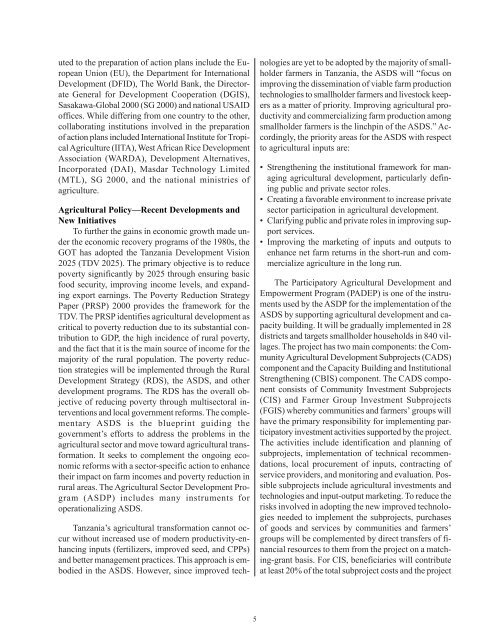An Action Plan for Developing Agricultural Input Markets in Tanzania
An Action Plan for Developing Agricultural Input Markets in Tanzania
An Action Plan for Developing Agricultural Input Markets in Tanzania
Create successful ePaper yourself
Turn your PDF publications into a flip-book with our unique Google optimized e-Paper software.
uted to the preparation of action plans <strong>in</strong>clude the European<br />
Union (EU), the Department <strong>for</strong> International<br />
Development (DFID), The World Bank, the Directorate<br />
General <strong>for</strong> Development Cooperation (DGIS),<br />
Sasakawa-Global 2000 (SG 2000) and national USAID<br />
offices. While differ<strong>in</strong>g from one country to the other,<br />
collaborat<strong>in</strong>g <strong>in</strong>stitutions <strong>in</strong>volved <strong>in</strong> the preparation<br />
of action plans <strong>in</strong>cluded International Institute <strong>for</strong> Tropical<br />
Agriculture (IITA), West African Rice Development<br />
Association (WARDA), Development Alternatives,<br />
Incorporated (DAI), Masdar Technology Limited<br />
(MTL), SG 2000, and the national m<strong>in</strong>istries of<br />
agriculture.<br />
<strong>Agricultural</strong> Policy—Recent Developments and<br />
New Initiatives<br />
To further the ga<strong>in</strong>s <strong>in</strong> economic growth made under<br />
the economic recovery programs of the 1980s, the<br />
GOT has adopted the <strong>Tanzania</strong> Development Vision<br />
2025 (TDV 2025). The primary objective is to reduce<br />
poverty significantly by 2025 through ensur<strong>in</strong>g basic<br />
food security, improv<strong>in</strong>g <strong>in</strong>come levels, and expand<strong>in</strong>g<br />
export earn<strong>in</strong>gs. The Poverty Reduction Strategy<br />
Paper (PRSP) 2000 provides the framework <strong>for</strong> the<br />
TDV. The PRSP identifies agricultural development as<br />
critical to poverty reduction due to its substantial contribution<br />
to GDP, the high <strong>in</strong>cidence of rural poverty,<br />
and the fact that it is the ma<strong>in</strong> source of <strong>in</strong>come <strong>for</strong> the<br />
majority of the rural population. The poverty reduction<br />
strategies will be implemented through the Rural<br />
Development Strategy (RDS), the ASDS, and other<br />
development programs. The RDS has the overall objective<br />
of reduc<strong>in</strong>g poverty through multisectoral <strong>in</strong>terventions<br />
and local government re<strong>for</strong>ms. The complementary<br />
ASDS is the bluepr<strong>in</strong>t guid<strong>in</strong>g the<br />
government’s ef<strong>for</strong>ts to address the problems <strong>in</strong> the<br />
agricultural sector and move toward agricultural trans<strong>for</strong>mation.<br />
It seeks to complement the ongo<strong>in</strong>g economic<br />
re<strong>for</strong>ms with a sector-specific action to enhance<br />
their impact on farm <strong>in</strong>comes and poverty reduction <strong>in</strong><br />
rural areas. The <strong>Agricultural</strong> Sector Development Program<br />
(ASDP) <strong>in</strong>cludes many <strong>in</strong>struments <strong>for</strong><br />
operationaliz<strong>in</strong>g ASDS.<br />
<strong>Tanzania</strong>’s agricultural trans<strong>for</strong>mation cannot occur<br />
without <strong>in</strong>creased use of modern productivity-enhanc<strong>in</strong>g<br />
<strong>in</strong>puts (fertilizers, improved seed, and CPPs)<br />
and better management practices. This approach is embodied<br />
<strong>in</strong> the ASDS. However, s<strong>in</strong>ce improved tech-<br />
5<br />
nologies are yet to be adopted by the majority of smallholder<br />
farmers <strong>in</strong> <strong>Tanzania</strong>, the ASDS will “focus on<br />
improv<strong>in</strong>g the dissem<strong>in</strong>ation of viable farm production<br />
technologies to smallholder farmers and livestock keepers<br />
as a matter of priority. Improv<strong>in</strong>g agricultural productivity<br />
and commercializ<strong>in</strong>g farm production among<br />
smallholder farmers is the l<strong>in</strong>chp<strong>in</strong> of the ASDS.” Accord<strong>in</strong>gly,<br />
the priority areas <strong>for</strong> the ASDS with respect<br />
to agricultural <strong>in</strong>puts are:<br />
• Strengthen<strong>in</strong>g the <strong>in</strong>stitutional framework <strong>for</strong> manag<strong>in</strong>g<br />
agricultural development, particularly def<strong>in</strong><strong>in</strong>g<br />
public and private sector roles.<br />
• Creat<strong>in</strong>g a favorable environment to <strong>in</strong>crease private<br />
sector participation <strong>in</strong> agricultural development.<br />
• Clarify<strong>in</strong>g public and private roles <strong>in</strong> improv<strong>in</strong>g support<br />
services.<br />
• Improv<strong>in</strong>g the market<strong>in</strong>g of <strong>in</strong>puts and outputs to<br />
enhance net farm returns <strong>in</strong> the short-run and commercialize<br />
agriculture <strong>in</strong> the long run.<br />
The Participatory <strong>Agricultural</strong> Development and<br />
Empowerment Program (PADEP) is one of the <strong>in</strong>struments<br />
used by the ASDP <strong>for</strong> the implementation of the<br />
ASDS by support<strong>in</strong>g agricultural development and capacity<br />
build<strong>in</strong>g. It will be gradually implemented <strong>in</strong> 28<br />
districts and targets smallholder households <strong>in</strong> 840 villages.<br />
The project has two ma<strong>in</strong> components: the Community<br />
<strong>Agricultural</strong> Development Subprojects (CADS)<br />
component and the Capacity Build<strong>in</strong>g and Institutional<br />
Strengthen<strong>in</strong>g (CBIS) component. The CADS component<br />
consists of Community Investment Subprojects<br />
(CIS) and Farmer Group Investment Subprojects<br />
(FGIS) whereby communities and farmers’ groups will<br />
have the primary responsibility <strong>for</strong> implement<strong>in</strong>g participatory<br />
<strong>in</strong>vestment activities supported by the project.<br />
The activities <strong>in</strong>clude identification and plann<strong>in</strong>g of<br />
subprojects, implementation of technical recommendations,<br />
local procurement of <strong>in</strong>puts, contract<strong>in</strong>g of<br />
service providers, and monitor<strong>in</strong>g and evaluation. Possible<br />
subprojects <strong>in</strong>clude agricultural <strong>in</strong>vestments and<br />
technologies and <strong>in</strong>put-output market<strong>in</strong>g. To reduce the<br />
risks <strong>in</strong>volved <strong>in</strong> adopt<strong>in</strong>g the new improved technologies<br />
needed to implement the subprojects, purchases<br />
of goods and services by communities and farmers’<br />
groups will be complemented by direct transfers of f<strong>in</strong>ancial<br />
resources to them from the project on a match<strong>in</strong>g-grant<br />
basis. For CIS, beneficiaries will contribute<br />
at least 20% of the total subproject costs and the project

















